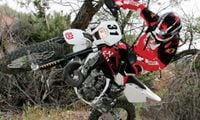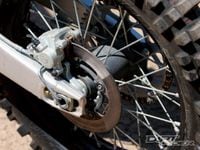These are viable questions: How good is the Husky 300? Is it as good as a KTM 300? And there isn't an answer that will make anyone happy, unless you're really looking for the truth. See, this bike is not as good as a KTM 300, the leader in this class for a number of reasons, starting with the push of the KTM's electric starter and finishing with performance advantages in lighter weight, better suspension and much better brakes. But that doesn't matter, we're talking about the Husky here and that's what we're going to do starting right now. If you can't get past what we just said, shame on you. We didn't park the bike after the first 10-minute ride and write what you wanted to read.The WR starts life on a tough note: the kickstarter. Everyone who kicked the awkwardly high, short and forward-placed kickstarter commented on it, and not in a good way. But at least you knew you were starting an Open-class machine. It starts easy with a heavy foot. As delivered, our bike needed some jetting. We leaned the needle all the way and dropped a couple of sizes on the main jet; the pilot had been dropped a size before we got the bike. It was a battle to get crisp response and not have detonation or end up just plain too lean. Our setting was not good for racing, but OK for trailing.Once jetted decently with a "factory jetting kit" which includes a much-needed needle, the WR becomes a rocket. It is fairly abrupt with the stock jetting, but with the new needle, the motor and its pull became smoother and faster at the same time. How fast? This bike walks away from 450cc four-strokes in a third-gear roll-on or even in hammer-down acceleration. Trust us, this bike is Open-class. Funny, because this motor does not act fast, it just is. The gear spacing is wide with a taller-than-perfect first gear, followed by manageable gaps between each of the rest going up. We'd likely add a couple of teeth to the rear sprocket to make the clutch's job easier when you want to go slow. The clutch does a good job, but the pull is too stiff with a longer than average throw.Some issues arise when we start getting picky, as the short shift lever and stiff clutch pull amplify notchy shifting. The bike has a vibration through the footpegs that drove some riders nuts, but the vibration, strangely, does not make it up through the handlebar. Yet the joy of the motor is at a cruising pace, where you let the motor live mostly in one gear and go from a just-above-idle lug to a surly top-end pull without having to shift; at throttle-it-along and back-off-to-change-gears pace, the WR is just fine. Just forget the clutch.The layout of the machine is pretty tall and very flat, but nicely comfortable for most riders. The seat is on the hard side at the back but drew few complaints. The bike fits all sizes of riders well and is never cramped or too spread out. In its design, the bike is one of the easiest machines to work on that we've ever thrown a wrench at.
On to the handling department and the Husky is a mixed up batch of characteristics that does nothing great and everything well. Blame could be directed at the fork. Its setup is a little on the stiff or sticky side, and we ended up running it pretty loose on the compression and rebound to make the bike plush. This made the bike feel too springy and made the turning a little vague, but was much better than having chop transmitted through the bar. The steering feels like it is out there (a lot of offset) but at the same time is light and planted. The WR feels like there is going to be plenty of stability, but at super-high speeds the bike can get nervous. When going really slow it can feel sluggish. Problematic fork seals liked to leak, until we had the fork rebuilt. The best trait was quite good bottoming resistance, even with low oil levels from the seal leaking. In the rear the Sachs shock does a fine job, especially when you get it set up; make sure you have a long screwdriver to get to the hard-to-reach rebound adjuster. We were running a bit more high-speed compression to help the turning and a little less low-speed compression to make the bike plush. If we could get the front to work as well as the back, the Husky would rival anything on the trail.One sore point on our bike was braking. The rear, equipped with a solid rotor, lacked feel and progression and locked too easily. The front also felt soft and then bit hard and suddenly; this after a good bleeding and cleaning of the pads.In today's market the level of refinement is so high that even the little things, like most of the issues raised with this bike, attracted some attention. Do they make it a bad bike? No, not at all. In fact, this Husky has a place where it really shines. Any time you are just riding. Not racing. Not going on a super-tough-guy ride. Just riding. Likely what most riders really do. That is where this bike rides right along and does it at a very acceptable level. If you're looking at a Husky, you most likely do not want to be another one of the crowd and want a unique ride. And often you can get one at a fair price as well, not to mention some of the discounts and sales promotions going on right now. Our experience with the bikes on a durability level has been good, fork seals notwithstanding, and the two-stroke is a time-proven design. So no, it is not a KTM or a Honda, but you didn't want it to be one of those in the first place.So now you know. If you're a Husky owner looking for affirmation, you already know a lot of this stuff, likely have fixed it or dialed the bike to your liking and are completely happy (tell us how you did it at DRmail@sorc.com). Or you own something else and want to see where the Husky ranks according to what you know about your bike (we won't hear from you). But we are lucky that there are bikes of all different flavors-a theme of this issue, you might have noticed.Trust us, if we always blew Husky two-stroke smoke all over the place to make everyone happy, we would not be riding bikes even as close to as good as this WR300. Competition is good and Husqvarna is hanging in there.
Opinions
Chris Denison
Height: 5'10"
Weight: 155 lb
Jump MonkeyThe WR300 motor had a deliberate hit that came on strong and pulled hard. I would've liked the motor to be a bit more "luggable" in that it was hard to ride off the pipe without the hard hit trying to steal the show . In terms of gearing, the Husky was in between first and second on tight trails, though where I could carry more speed I felt a little more comfortable. The suspension felt like it was "more springs than valving" and had a somewhat kicky edge to it that had the rebound feeling slightly abrupt but would still blow through on super-hard hits. The ergonomics of this bike take some getting used to, though I liked the narrow feeling of the bar (and the rest of the machine, to an extent). The kickstarter needs to be enlarged to twice its size. The clutch pull was slightly tight and the brakes were weak at best (much of which could be attributed to the excess of fork oil on the front rotor), and I wasn't super stoked with the huge amount of vibration coming from the bike. Given some more time to adapt, a little tuning on the suspension, a little TLC to the chassis and maybe some gearing changes, I could definitely get this bike to a more race-ready point.Alexander Smith
Height: 6'1"
Weight: 155 lb
Excellent DriverThe WR300 had a pretty serious hit in the powerband that reminded me of an RM250 motocross bike (not necessarily a bad thing). I was impressed how the bike would lug so low and not stall; but the hit was there waiting to save the day if you got in trouble. The bike had more vibration in the footpegs than I like, and the ergonomics left something to be desired. The kickstarter is the first hint as to why Jimmy Lewis calls this bike "Stumpy." The shift lever seems short, high and too far in. It seemed like the throw between shifts was considerably longer than on the average bike; I don't think I ever went from first to second without hitting neutral. The steering felt good; fast enough to be ridable on tight trails but not too fast to make it scary on fast roads. I felt that the suspension was acceptable for a stock motorcycle, however oversprung it might have been (a sensation which might have been due to the leaky fork). Improved ergonomics could make the biggest improvement to Husky's WR.Karel Kramer
Height: 6'1"
Weight: 215 lb
B RiderAfter racing a Husky four-stroke at a GNCC I was eager to hit some trails on the Husky 300 two-stroke. It was a nice surprise. Of the three 300 two-strokes available, I find the Husky far more pleasant than the Gas Gas. It also has some facets that improve on the class-leading KTM. The Husky has a better seat, exceptional off-idle chugability and nice hand-holds to lift the bike. It still needs a diet, more controlled suspension and an E-button to knock the KTM off the pedestal, but if you like something simpler and with a linkage, the Husky certainly has the goods.



/cloudfront-us-east-1.images.arcpublishing.com/octane/3T32INAZQRGPXOGGA36NQJDSSM.jpg)
/cloudfront-us-east-1.images.arcpublishing.com/octane/EPLS5PBKXBHNXK7S5O7G4ND3YQ.jpg)
/cloudfront-us-east-1.images.arcpublishing.com/octane/MNGOZAGZFZBH5DPFV7NOPF5S3Y.jpg)
/cloudfront-us-east-1.images.arcpublishing.com/octane/VGJWIIFM2VBCXG34KRQ37GCP7U.jpg)
/cloudfront-us-east-1.images.arcpublishing.com/octane/2ZU3HXRPMZESJF7HDLZJV7FHEY.jpg)
/cloudfront-us-east-1.images.arcpublishing.com/octane/VVFWQBZEIZDVJHZIW5ISKWKOZU.jpg)
/cloudfront-us-east-1.images.arcpublishing.com/octane/7T7FZXHIIBDX7AOBD5S3IICUJI.jpg)
/cloudfront-us-east-1.images.arcpublishing.com/octane/T3Y7A52TXBEBJNEPGOQSVPQSPU.jpg)
/cloudfront-us-east-1.images.arcpublishing.com/octane/KY33U3WBTNFIBJFMTEF2SM7BOQ.jpg)
/cloudfront-us-east-1.images.arcpublishing.com/octane/JNPS5MGVXJC7BARVMARYQIQHXE.jpg)
/cloudfront-us-east-1.images.arcpublishing.com/octane/63N2P6SYAZDURJDO5KARQYX2J4.jpg)
/cloudfront-us-east-1.images.arcpublishing.com/octane/C72WX35SXFETTO5OVA2RWT523I.jpg)
/cloudfront-us-east-1.images.arcpublishing.com/octane/F3ER37EV2RGY5CRYFNTWE3JSF4.jpg)
/cloudfront-us-east-1.images.arcpublishing.com/octane/L65QCUR32RH2NKCUHXYHHAPDFI.jpg)
/cloudfront-us-east-1.images.arcpublishing.com/octane/VSK246VVRRDMBNQU7B2NTNY6AE.jpg)
/cloudfront-us-east-1.images.arcpublishing.com/octane/CG64RRFAYRENNAP2AA22T2LSJY.jpg)
/cloudfront-us-east-1.images.arcpublishing.com/octane/IKZSRLBWMRDORMORBXSISL4D6M.jpg)
/cloudfront-us-east-1.images.arcpublishing.com/octane/BJLVRPJSDFC3ZLPMW3LYYHMPZE.jpg)
/cloudfront-us-east-1.images.arcpublishing.com/octane/RQW2RFU4MJDYRPVFJNW362SEXU.jpg)
/cloudfront-us-east-1.images.arcpublishing.com/octane/CGQDU7HEEBBWBLF6SMXCJIW7DI.jpg)
/cloudfront-us-east-1.images.arcpublishing.com/octane/B35XXACE4ZGU5BWSEMEFUL6SN4.jpg)
/cloudfront-us-east-1.images.arcpublishing.com/octane/TDSGY4VSSRC4LP6PYXP62U236Y.jpg)
/cloudfront-us-east-1.images.arcpublishing.com/octane/4YWNAG64EZF63AQI3VL7ANERSY.jpg)
/cloudfront-us-east-1.images.arcpublishing.com/octane/QFQQG7ZZKFB5VC7C7B5PTOCJ2E.jpg)